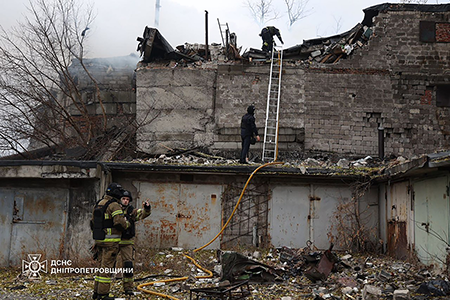"[Arms Control Today] has become indispensable! I think it is the combination of the critical period we are in and the quality of the product. I found myself reading the May issue from cover to cover."
Ukraine, Russia Exchange Missile Fire After U.S. Shift
December 2024
By Xiaodon Liang
Ukraine conducted a missile strike Nov. 19 on an armament depot in the Bryansk region of Russia using what Ukrainian and U.S. media described as U.S.-supplied short-range ballistic missiles. The strike took place days after the United States authorized such attacks following months of pressure from Ukraine.

Russia responded two days later by launching a previously unknown intermediate-range ballistic missile at the Ukrainian city of Dnipro as part of a large-scale missile attack. The new missile, called the Oreshnik in televised comments by Russian President Vladimir Putin on Nov. 21, was targeted at facilities that historically have been involved in Ukrainian missile production.
Reuters, The New York Times, The Washington Post, and other media outlets reported on Nov. 17 that they were briefed by unnamed U.S. officials that the Biden administration had lifted its policy barring Ukraine from using U.S.-origin missiles to strike targets far behind the frontlines of the Russian invasion. (See ACT, October 2024.)
Ukrainian President Volodymyr Zelenskyy referred to but did not confirm the decision in a Nov. 17 address. “[S]trikes are not carried out with words. Such things are not announced. Missiles will speak for themselves,” he said.
The United States has provided Ukraine with the Army Tactical Missile System (ATACMS), a short-range ballistic missile with a range of roughly 300 kilometers. These missiles were first used in attacks against Russian forces within occupied Ukraine last year. (See ACT, November 2023.)
But the first use of these weapons against targets in Russia came in the morning of Nov. 19, when the Ukrainian military confirmed it had attacked an armaments depot in the city of Karachev in Bryansk. RBC Ukraine and The New York Times, citing unnamed Ukrainian and U.S. military sources, reported that the strike was conducted using ATACMS.
The same depot was the target of a Ukrainian drone strike in early October. U.S. officials have said that permitting attacks with U.S.-origin weapons systems would not affect the military balance of the war because Ukrainian drones were already capable of reaching Russian targets far behind the frontlines. (See ACT, October 2024.)
The Russian Ministry of Defence said Nov. 26 that Ukraine had conducted additional ATACMS strikes against an airfield and air defense site in the Russian territory of Kursk, Reuters reported.
Ukraine also fired UK-supplied Storm Shadow cruise missiles at targets in Russia for the first time, the BBC reported on Nov. 20. Because these missiles contain U.S.-origin components, they also were subject to the restrictions of the now-lifted U.S. policy.
Official confirmation of the U.S. policy shift came a week after initial reports, when John Kirby, White House national security communications adviser, said in a Nov. 25 press briefing that “we did change the guidance and gave them guidance that they could use them.”
According to media reports, the shift in the Biden administration’s policy was prompted by the arrival of North Korean troops in support of the Russian invasion. The United States believes that about 11,000 North Korean troops are serving in Kursk, where Ukrainian forces have pushed across the international border, according to Nov. 18 comments by a U.S. Defense Department spokesperson.
The decision to permit strikes with U.S.-origin weapons “is reckless, dangerous, aimed at a qualitative change, a qualitative increase in the level of involvement of the United States in this conflict,” Russian presidential spokesperson Dmitry Peskov said Nov. 18, according to Reuters.
Following the strike involving the new Russian intermediate-range missile, Peskov told journalists that “[t]he main message is that the reckless decisions and actions of Western countries that produce missiles, supply them to Ukraine, and subsequently participate in strikes on Russian territory cannot remain without a reaction from the Russian side,” Reuters reported.
A U.S. Defense Department spokesperson said on Nov. 21 that the Oreshnik is an intermediate-range missile derived from the RS-26 intercontinental ballistic missile (ICBM), although Russia has described the new weapon as a “medium-range” missile. The Oreshnik had six warheads, according to a Ukrainian military intelligence press release on Nov. 22.
The RS-26 is classified as an ICBM because it was tested to a range of more than 5,500 kilometers. But during development, Russia also tested the missile at intermediate ranges, raising questions about whether it challenged the spirit of the now-defunct Intermediate-Range Nuclear Forces Treaty. Because these tests did not create a violation of the letter of the treaty, the RS-26 was not central to U.S. allegations of Russian noncompliance. (See ACT, April 2014.)
